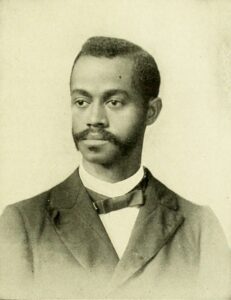9 Charles Henry Turner
Dr. Charles Henry Turner |
|
Time period:1867-1923 Subject:Zoology |
|
Biography:Born in Cincinnati, Ohio on February 3, 1867 (2 years after the end of slavery), to two middle-class parents (a church custodian and a nurse). He married his wife, Leontine Troy, in 1886 and had 3 children named Darwin, Louise, and Henry. He was the first African American to receive a BSc. in 1891, his MSc. in 1892, both from the University of Cincinnati and his eventual Ph.D. in 1907. He published more than 70 papers, including 2 solo-authored papers to Science, the journal in which he was the first African American man recognized. Despite all these accomplishments, the reason it took so long to accomplish his Ph.D. was that he was never granted a position at a major US university, and was thus unable to research with the best equipment or resources. He was almost granted a position at the University of Chicago, but the hiring person died, and the successor did not want an “N-slur”. (Dona & Chittka, 2020). Despite his groundbreaking work on insect intelligence, learning, and will, which is still a focus of study today, he worked at an African American high school for the majority of his academic career. While he worked there, he witnessed the East St Louis Massacre where 100+ African Americans were killed and thousands of their homes burnt down. He was active in US Civil Rights and believed education and conscious effort were the keys to eliminating racism, and it could be accomplished in a few decades.
|
|
Summary of their contributions:Researched and discovered honey bees can learn and recognize colours and patterns. Experiments showed that insects and lizards are capable of learning. Published 71 papers by the time he passed away at 56 years old, mostly focused on animal learning.
|
|
Integration with the BC Secondary Science Curriculum:Curricular Competencies: Charles H Turner is an example of diversity in STEM, and could be a great discussion when facilitating the Curricular Competency of “Consider the role of scientists in innovation”. His methodologies were considered very rigid, and his work could be used in a project for any competency in the “Evaluating” section. His research is considered quite rigid methodologically and would serve as an excellent example discussing experiment and research methods in “Planning and conducting”. Evolution: When discussing evolution, Charles H. Turner (who incidentally named his son Darwin), one could create a class discussion on how the traits of intelligence could have evolved, or aided in fitness.
|
|
References:Charles Henry Turner (zoologist). (2023). In Wikipedia. https://en.wikipedia.org/w/index.php?title=Charles_Henry_Turner_(zoologist)&oldid=1182136674 Dona, H. S. G., & Chittka, L. (2020). Charles H. Turner, pioneer in animal cognition. Science, 370(6516), 530–531. https://doi.org/10.1126/science.abd8754 More than mere insects: The brilliant mind of Charles Henry Turner. (n.d.). World Wildlife Fund. Retrieved December 10, 2023, from https://www.worldwildlife.org/stories/more-than-mere-insects-the-brilliant-mind-of-charles-henry-turner Radio ·, C. B. C. (2021, August 13). Meet 7 groundbreaking Black scientists from the past | CBC Radio. CBC. https://www.cbc.ca/radio/quirks/black-scientists-history-1.5918964 |
|


